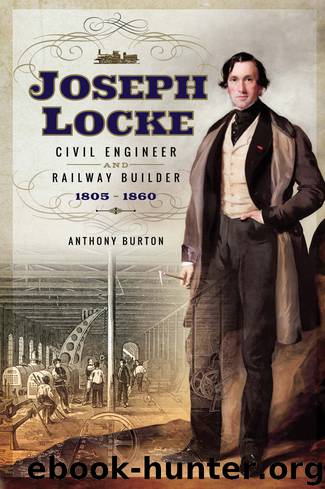Joseph Locke by Burton Anthony;

Author:Burton, Anthony;
Language: eng
Format: epub
Tags: TRANSPORTATION / Railroads / General
Publisher: Pen and Sword
Published: 2017-11-30T05:00:00+00:00
Chapter Ten
RAILS NORTH
One of the problems of writing a neat, chronological biography of any engineer is that projects usually overlap instead of following each other in neat succession. The engineer is unlikely to be working on just one line at a time, and this was certainly true of Locke. There was a brief mention in the last chapter of negotiations about French railways taking place in Scotland, where he was Chief Engineer for the Glasgow, Paisley & Greenock Railway. It is now time to backtrack and look at that line in more detail.
The story really begins with the history of the Clyde. Today, we think of it as a mighty river, famous for its ship-building industry, which saw the launch of such celebrated vessels as the Queen Mary. Yet at the beginning of the eighteenth century, the river in Glasgow was so shallow that many of its citizens used to ride across on horseback rather than pay the toll to use the bridge. Improvements were put in place in the latter part of that century, but it was still impossible for sea-going vessels to reach Glasgow itself. This led to Greenock’s development as the main port near the mouth of the river, from where everything had to be transhipped into smaller river craft. There was an attempt to improve matters by the construction of the Glasgow, Paisley & Ardrossan Canal, authorised in 1806. It never even got much beyond Paisley, before work was abandoned. At the start of the railway age, there was a plan to extend the canal by means of a railway, but this would have been very much on the older pattern, involving a great deal of haulage by stationary engines. There were also a number of tramways connecting to the river, mostly built to a 4ft 6in gauge, and for a time it seemed possible that that would become the standard gauge for Scotland, but wiser councils prevailed, and it was agreed to match the lines already well advanced south of the border. As the development of Greenock moved forward, the need for a better connection to Glasgow became ever more pressing.
Two companies were formed: the Glasgow, Paisley & Greenock and the Glasgow, Paisley & Ardrossan. It was at once obvious that Parliament was highly unlikely to authorise two parallel routes, linking the same places, so agreement was reached that the line between Glasgow and Paisley should be built and operated jointly. From Paisley, the line to Ardrossan swung off in a wide arc to the south, while the other line took a more northerly route. Once agreement had been reached the Acts for the two lines were approved, and it was agreed that to make construction simpler, the incomplete canal to Paisley could be filled in. It must rank as one of Britain’s least successful and shortest-lived canals. Locke was appointed as Chief Engineer for the line to Greenock and his Resident Engineer was to be the man he had first met while working in Stockport, and who had worked with him on the Grand Junction, John Errington.
Download
This site does not store any files on its server. We only index and link to content provided by other sites. Please contact the content providers to delete copyright contents if any and email us, we'll remove relevant links or contents immediately.
| Automotive | Engineering |
| Transportation |
Small Unmanned Fixed-wing Aircraft Design by Andrew J. Keane Andras Sobester James P. Scanlan & András Sóbester & James P. Scanlan(32573)
Navigation and Map Reading by K Andrew(4889)
Endurance: Shackleton's Incredible Voyage by Alfred Lansing(4504)
And the Band Played On by Randy Shilts(2014)
Wild Ride by Adam Lashinsky(1870)
The Box by Marc Levinson(1861)
Top 10 Prague (EYEWITNESS TOP 10 TRAVEL GUIDES) by DK(1851)
The Race for Hitler's X-Planes: Britain's 1945 Mission to Capture Secret Luftwaffe Technology by John Christopher(1741)
The One Percenter Encyclopedia by Bill Hayes(1717)
Trans-Siberian Railway by Lonely Planet(1629)
Girls Auto Clinic Glove Box Guide by Patrice Banks(1619)
Looking for a Ship by John McPhee(1572)
Batavia's Graveyard by Mike Dash(1549)
TWA 800 by Jack Cashill(1523)
Fighting Hitler's Jets: The Extraordinary Story of the American Airmen Who Beat the Luftwaffe and Defeated Nazi Germany by Robert F. Dorr(1517)
Troubleshooting and Repair of Diesel Engines by Paul Dempsey(1498)
Good with Words by Patrick Barry(1496)
Bligh by Rob Mundle(1488)
Ticket to Ride by Tom Chesshyre(1479)
